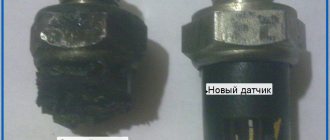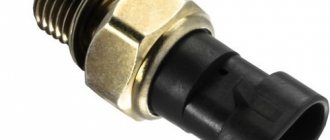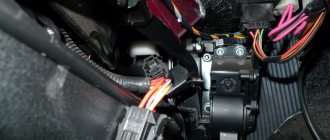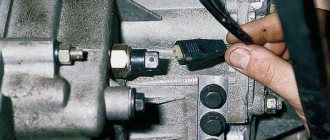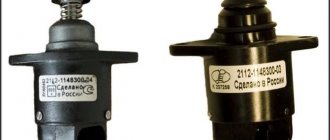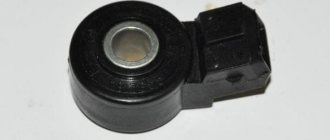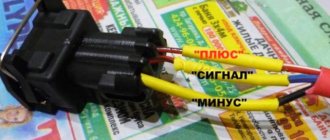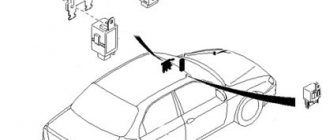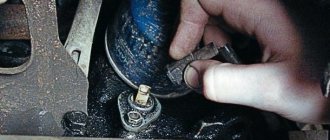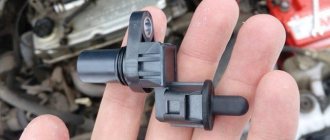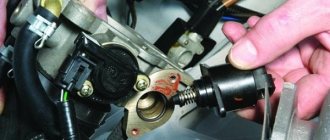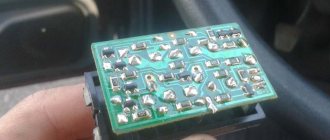Causes of failure
Before you start replacing the reverse sensor (RDS), we recommend checking the condition of the rear lights and determining whether the signal may not be working for other reasons.
| Possible reason | Your actions |
| Burnt out light bulbs | A common and fairly banal cause of problems, which, nevertheless, many ignore. Take out the light bulb, arm yourself with a multimeter and check if they have burned out. Replace if necessary |
| Wiring is damaged | The problem is no less common, but looking for the source of the problems in such a situation is a little more difficult. You will also need a multimeter, which you need to test the wiring and check the resistance readings |
| Poor regulator contact | It happens that during operation the contact of the sensor with the socket is broken. Lack of contact means that the device will not work normally. So check its condition |
| Wiring insulation is broken | If the insulation on the wires near the sensor is broken, this can lead to a short circuit. The result is quite obvious, so check the condition of the wiring and replace it if necessary |
| Fuse burned out | Depending on the type of fuse box, check the condition of the corresponding element in the mounting block. On old-style blocks this is fuse F16, and on new-style fuse blocks you should look at fuse 5. If they are melted, they will need to be replaced. But it is also important to determine the reason why the fuse blew |
| Sensor failure | A failure of the reverse control itself may be indicated by a situation where the lights do not light up at all or, on the contrary, light up without interruption. In the second case, the option of burnt out light bulbs is excluded by itself. |
Replacing a reverse sensor is not a difficult or financially expensive job. Today, the DZH can be purchased at any auto parts store, and its cost is about 100 rubles.
Characteristics of the 3X sensor
If problems occur with the sensor, you need to immediately pay attention to the light bulbs and the sensor itself.
Purpose and principle of operation
The main task of this device is to turn on the warning lights, notifying people that the car is moving in reverse. It is clear that if the device is unusable, accidents may occur.
The VAZ 2109 reverse sensor works in this way: when changing gears, the shift fork is pressed against the device. This creates a short circuit in the wire and turns on the light, which informs about the movement of the vehicle in reverse.
Typical faults
The most popular problems are:
- The light bulbs burned out. If this happens, you need to remove it and check it with a multimeter.
- Broken contacts.
- The device will not work if the regulator contact is poor, as well as if the contact insulation is poor. Violation of insulation threatens to cause a short circuit.
- In the event of a breakdown, you need to make sure that the fuse in the mounting block is in good condition. If it is damaged or melted, it is worth replacing immediately.
- If the device itself fails, and the symptoms of the malfunction are such that all the lights will not work or, conversely, will work continuously, you need to replace it with a new one.
Functionality check
So, don’t rush to spend money and buy a new sensor. First make sure that the old one really doesn't work.
The check is performed as follows:
- Using a jack, place the car on supports;
- Locate the sensor, which is located on the gearbox housing;
- Engage reverse gear;
- There must be continuity between terminals 1-3 and 2-4;
- Check continuity in neutral in the same way;
- When turning the box in other positions, there should be no conductivity;
- If checking the regulator shows the opposite, you will have to change the DZH.
Location of DZH
Replacement
The instructions for replacing the reverse sensor will not cause difficulties for more or less experienced car owners, but beginners will have to try to do everything correctly and accurately.
You should not be afraid to change this sensor yourself, because if you follow the instructions and safety measures, everything will work out.
- It is advisable to have a garage with a pit at your disposal. This will make it most convenient for you to complete all operations to replace the sensor.
- Remove the negative terminal from the battery. All work related to car repair and especially its electrical component should begin with this step.
- Drain the gearbox oil. You don’t have to do this, but then when replacing the sensor, oil will start leaking out. By placing a container under the hole, you will save yourself from unnecessary cleaning and oiling of your own garage.
- Remove the crankcase protection, if any. Near the gearbox you will find the sensor you are looking for.
- Disconnect the sensor block from the gearbox.
- In the gearbox housing, the desired regulator is held in place using a mounting bolt. Unscrew the clamping bolt with a 22mm socket or ratchet.
- Armed with the new sensor, you may notice that it somewhat resembles a classic spark plug. On one side of the sensor there is a wire, and on the other there is a button that closes a pair of contacts.
- New DZHs are required to be equipped with O-rings. Before installation, they must be lubricated with ordinary oil - machine oil, transmission oil.
- Install the new regulator in place of the removed device, first secure it by hand, and then tighten the mounting bolt.
- Next up is the electrical wiring. By connecting the block with wires, you will provide the sensor with the necessary power.
- Fill the gearbox with previously drained or new transmission oil. Replacing the reverse sensor is an excellent reason to change the lubricant in the gearbox housing. But the decision is yours.
- Check the gearbox oil level to ensure it meets the specifications.
- Replace the crankcase protection, remove the car from the jack and connect the negative terminal back to the battery.
- Get into the car and put the car in reverse gear.
- If after this the reverse light comes on, everything is fine.
Disable and change
Upon completion of work, do not forget to perform a full performance check of the VAZ 2109 with a brand new reverse sensor.
Checking repairs
Theoretically, after replacing the sensor, everything should work as before. But it wouldn’t hurt to make sure of this.
- Engage reverse gear at the gearbox.
- Turn the ignition key. In this case, it is not at all necessary to start the engine. The light will light up if everything is working properly.
- If both lights come on, half the job is done.
- It would be a good idea to additionally check the operation of the sensor while driving. For this you will need an assistant.
- Drive out of the garage, then reverse back. And repeat this several times. If the lamps do not blink and turn on in time, you have succeeded. Congratulations.
If suddenly replacing the sensor does not produce any result, we strongly recommend that you carefully study the possibility of each of the above breakdowns, check the wiring, light bulbs and other components. Obviously, the problem is in one of them or several at once.
Symptoms of a problem
Under no circumstances should you ignore signs of failure of the idle speed sensor on your injection or carburetor VAZ 2109. This will make driving uncomfortable at first, but can soon cause a serious accident.
There are several main symptoms that may indicate problems with ICC:
- The revolutions spontaneously begin to increase and decrease;
- When turning on a cold power unit, the speed does not increase;
- When using additional electrically dependent devices, such as headlights or a heater, the speed immediately begins to drop at idle;
- When shifting gears or idling, the engine may stall.
This is not a complete list of possible symptoms, but they are all indirect. Therefore, to make sure that the problem lies precisely in the IAC, and not in other engine components, it is necessary to check the current state of the sensor.
Checking status
To check the current state of your IAC on a VAZ 2109 car, follow several sequential steps.
It will be useful: The wrong Mazda was recalled in Russia
Verification step
Your actions
Apply the handbrake on the car and install chocks under the wheels. Safety should always come first when doing DIY car repairs.
You need to get to the sensor you are looking for, disconnect it from the power supply with wires, and then use a voltmeter to check for voltage. The minus is placed on the engine, and the plus is installed on the terminals of the wire block A and D
Turn on the ignition, check the voltage readings. Normally they are about 12 Volts. If the voltmeter shows lower values, there may be a problem with the battery charge level. If there is no voltage at all, you will have to check the entire computer and electrical circuit. Breaks are possible.
Carry out another test with the ignition on. Check terminals AB and CD one by one. In normal condition, the resistance across them should be approximately 53 ohms. If the IAC is working normally, the meter will show infinite resistance
With the idle speed control removed and the ignition on, connect the power supply to it. If at the same time the conical needle moves out, everything is fine with the device. If the cone-shaped needle does not extend, then the IAC is out of order and requires replacement
Having determined that the old idle speed sensor has already served its purpose on the VAZ 2109, it needs to be replaced. The procedure is completely doable without outside help.
Removing the IAC
Where is the VAZ-2109 reverse sensor located and replaced?
Some car enthusiasts are faced with a malfunction of the reverse sensor for the VAZ-2109.
Possible causes of malfunction
Reversing lamps may stop working for several reasons:
- malfunction;
- the fuse just blew;
- violation of the ground connection from the body to the rear lights;
- malfunction of the lamp itself;
- oxidation of contacts in the cartridge;
- problems with electrical wiring.
Location
This sensor is located on the gearbox. When the hood is open or under the bottom of the car in the lower part on the left wheel side, it is easily visible. The red wire supplies power to it (only after the engine is turned on), and the green wire powers the reversing lights.
Examination
It is easy to check the serviceability of the reverse lamps. You need to disconnect the wires suitable for the device, then connect them together (for example, with a piece of wire). If the headlights come on, then the sensor is faulty and needs to be replaced.
Frequent breakdowns are associated with deterioration in the quality of sensor manufacturing. Over time, its tightness is broken, and oil gets inside. Many inexperienced car enthusiasts associate this with different fuel supply systems - carburetor or injector. But this has nothing to do with this malfunction. You just need to monitor the condition of the sensor from time to time.
Replacement
Many people ask the question: where should you change the reverse sensor?
Of course, the easiest way is to take the car to a service station, where they will replace it at a price of 3-4 times its cost. But you can change it yourself, there’s nothing complicated about it. Let's look at the step-by-step instructions:
- It is necessary to remove the engine protection, if equipped.
- Turn off the electrical power and disconnect the wires connecting to the sensor.
- Prepare a container for oil, since all front-wheel drive cars leak oil when replacing reverse sensors.
- Using a 22mm wrench, preferably with a long ratchet type head, we try to remove the sensor. In this case, a problem may arise - the old thread does not allow it to be unscrewed. Then you need to arm yourself with a hammer and chisel.
- As soon as it is unscrewed, we substitute the oil container.
- We insert a new one very quickly.
- Using the same key, tighten it.
- We connect the wires and check the operation of the reversing lights.
- If everything works, add the leaked oil and install protection.
A malfunction of the reversing lights is not critical to the operation of the vehicle. But the key to safe driving is maintaining the entire vehicle in good condition.
Characteristics of the XX controller
This part is designed to reduce the engine warm-up time. During this operation, rubbing parts often wear out quickly. So: DXX is also designed to reduce contact and wear. This device is mounted in the throttle assembly, which is located in the engine compartment on the left side of the engine.
It will be useful: How to fix engine problems on a Renault Logan: photos and videos
Purpose and principle of operation
Main components of the device:
- stepper electric motor;
- conical needle combined with a rod;
- springy part.
Idle speed sensor
As shown in the photo, the device has blocks. The main mechanism is highlighted in red - the idle speed sensor VAZ 21099 injector. The adjusting part that controls the engine speed is visible in gray. Blue – a device designed to read information about the crankshaft rotation speed. If the operation is idling, the air flow enters the main cylinders through special channels.
The green color in this diagram is responsible for comparison in the electronic unit. Here the engine speed is taken into account in accordance with the actual speed.
The coolant temperature sensor also receives the necessary signal. Until the comparison circuit receives the necessary information, the engine will operate at higher speeds. At this time, the air is adjusted using the conical part of the needle. A disruption in the air supply often leads to breakdowns and a complete stop of the motor.
Drawing a conclusion, we can say that a certain amount of air enters the engine - exactly as much as is needed for operation in a suitable mode. This volume is taken into account by a special air flow meter. It transmits information to the controller, which, depending on the value, prepares the mixture at the required concentration. After this, it is injected through the injector nozzles into the vehicle network. You can find out where the idle speed sensor is located on the VAZ 21099 injector in the photo below.
Typical faults
Popular and frequent breakdowns of the VAZ 2109 carburetor and injector idle speed sensor include the following:
- engine malfunction;
- refusal to act when the gas pedal is released;
- uncontrolled idling, even when the engine is warm;
- when the gear is switched off, the engine stalls;
- when the engine is cold, the crankshaft does not increase rotation (video author - Devyatochka.remont).
Replacing the reverse sensor
I TURNED THESE KEYS to 22
The reverse light did not work. The reason was the reverse sensor (switch). BUT IT'S NOT SO SIMPLE... The key barely fits there, the SWITCH was stuck, the edges stuck together with a regular key, I decided to break the plastic of the sensor, in order to insert the key and unscrew it I had to spray WD-40. As the car moves, the sensor is located on the left side.
THIS IS THE KEY I HAD TO INSTALL AND BREAK THE PLASTIC THERE WAS NOT A WIDE HEAD UNDER HAND
NEW SENSOR
IN ORDER TO GET TO THE SENSOR YOU HAD TO REMOVE THE PROTECTION
SO THE NEW SENSOR IS INSTALLED
WD-40 It is used in the weapons and aerospace industries, aviation, electromechanical manufacturing, in the office, at home, everywhere! Everyone knows that using WD-40 can easily unscrew a rusty nut or prevent locks from freezing
Remember! Replacing a reverse sensor on a front-wheel drive vehicle is characterized by small oil leaks from the gearbox housing.
How to check the reverse sensor of a VAZ 2109
What should you do if, when you engage reverse gear in 9, the reverse lights stop working? This is very dangerous, especially in the dark, since other drivers do not see that you are moving in reverse and incorrectly assess the road situation. Therefore, the problem with the reverse gear must be eliminated as quickly as possible. The fact that the reversing lights do not light does not mean that the reversing sensor is faulty. First you need to check the reversing light bulbs. If they are working properly, then remove the connector from the reverse sensor (it is screwed into the gearbox) and make sure that the connector is in good condition. The wires must not be oxidized and sit securely on the connector contacts. Please note that there are several types of reverse sensors installed on the ninth model of Zhiguli.
Single contact sensor
Reverse sensor VAZ 2109 with one contact
Sensor with two contacts
Reverse sensor VAZ 2109 with two contacts
1) When reverse gear is engaged, the reverse gear fork presses on the front of the sensor and shorts the wire to ground. As a result, the reverse lights come on. Therefore, to check the sensor, we simply turn on the ignition, remove the chip from the sensor and short it to ground. If the lights come on, the sensor is faulty.
2) If a sensor with two contacts is installed in the gearbox, then when reverse gear is engaged, these contacts close together. Therefore, checking the serviceability of such a reverse sensor is also extremely simple. Turn on the ignition, remove the connector from the sensor and close the contacts with a jumper. The reversing lights should light up at the moment of closing.
If you are convinced that this sensor is not working properly on your car, then it needs to be replaced. The old sensor must be unscrewed and a new one screwed in instead. The only bad thing is that when the old sensor is unscrewed, oil will flow from the gearbox, so we immediately screw in a new reverse sensor.
Description of DZH
Purpose
Let's start with the purpose. DZH is a device designed to activate white lamps, indicating that the car is in reverse gear. The device is used to turn on the reversing lights, which allows other road users to know the driver's intentions and the maneuvers he is about to perform.
When it's dark outside, white headlights will also help warn drivers behind you that your car is in their path. This, in turn, helps prevent possible incidents and emergency situations on the road. Where this device is located - the location may vary slightly, but as a rule, the controller is located on the gearbox.
Design and principle of operation
The DZH itself consists of a housing, contacts for connection, a rod, a moving ball, and a return spring.
As for the operating principle, it is as follows:
- The driver shifts the transmission lever to the reverse gear position.
- In this case, the gear shift fork is pressed against the controller.
- Next, the device shorts the cable to ground.
- After this, the light source installed in the rear lights is activated, which warns other drivers that the car has started to reverse.
Symptoms of a problem
What signs of malfunction may indicate a breakdown of the DZH:
- One of the problems that happens most often is oxidation of contacts on the terminals or wiring. This problem is relevant for many car owners. To solve this problem, it is necessary to thoroughly clean the contacts and then install them in place. When performing this work, the battery should be disconnected. If the contacts are inoperative due to the fact that they are burned out, then they will have to be changed in any case. But before making a replacement, it is necessary to find out why the burnout occurred; most likely, the essence of the problem lies in voltage surges in the on-board network.
- The device became loose in its seat. During vehicle operation, the controller may slightly move out of its installation location; this problem is usually caused by high vibrations. In this case, you will simply need to more securely fix the device at the installation site.
- Another reason for inoperability is the lack of contact with the on-board network in the gearbox. In this case, it is necessary to diagnose the condition of the contacts, as well as electrical circuits. If necessary, failed components must either be cleaned or replaced.
- The next problem is that there is no contact between the connection connector and the safety mounting block. In this case, you also need to diagnose the condition of the contacts, as well as clean and change the wires, if necessary.
- Failure of the safety device. In this case, the problem can only be solved by replacing the fuse. If this part often fails, then the reason may lie in the same voltage surges. It is necessary to check the electrical circuit more carefully.
- The reverse light may not turn on because the light source itself, that is, the lamp, has burned out. In this case, you will have to dismantle the optics cover in the trunk and replace the failed device.
- And finally, the last reason for inoperability is the breakdown of the DZH. In this case, you will not be able to repair it, since such devices, as a rule, cannot be repaired. The controller will need to be changed (the author of the video is the Do-It-Yourself Auto Repair channel).
